Transitioning from traditional agricultural methods to agroforestry often requires a shift in mindset and education. The Savanna Institute aims to speed that shift by showing farmers just what’s possible.
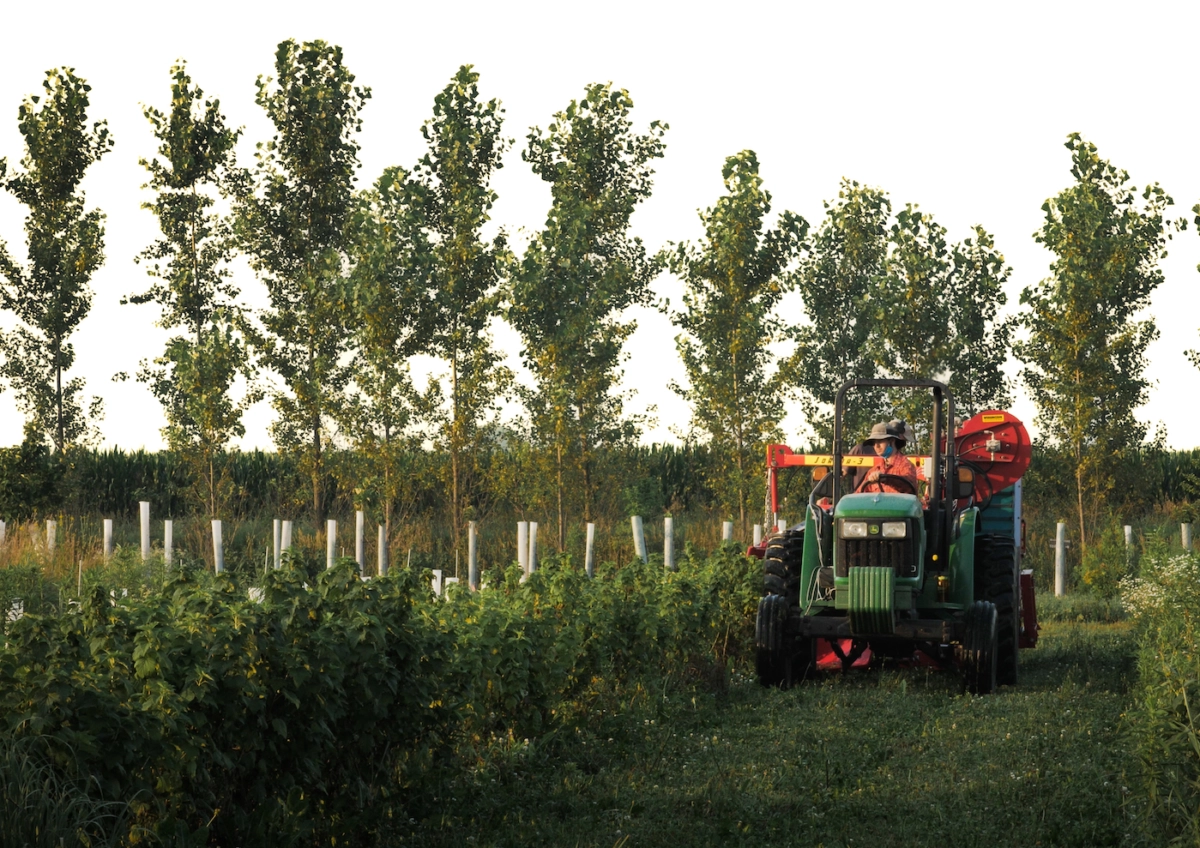
“There’s nothing more simple or effective than a tree for sinking carbon, especially in places where we’ve been killing soils and releasing carbon for a long time,” enthuses Kaitie Adams. As director of demonstration and on-farm education for the Savanna Institute (SI), she knows that agroforestry can be a game-changer in fighting climate change and creating healthier food systems.
The U.S. Department of Agriculture’s (USDA) Climate Change Resource Center recognizes agroforestry, the intentional integration of trees and shrubs into agricultural practices, as a promising option to weave productivity and profitability into sustainable and resilient farming systems. Over the past decade, USDA initiatives have created multiple partnerships among nonprofits and universities throughout the country, including SI in the Upper Midwest, University of Missouri in the Lower Midwest, Propagate in the Northeast and Tuskegee University in the Southeast, to meet a growing interest in agroforestry.
Transitioning from traditional agricultural methods to agroforestry often requires a shift in mindset and education. Building out an agroforestry demonstration farm network offers more hands-on educational opportunities and tours for farmers and growers to see what agroforestry looks like, how trees fit into farming landscapes, why they enhance conservation and how they can be economically viable.
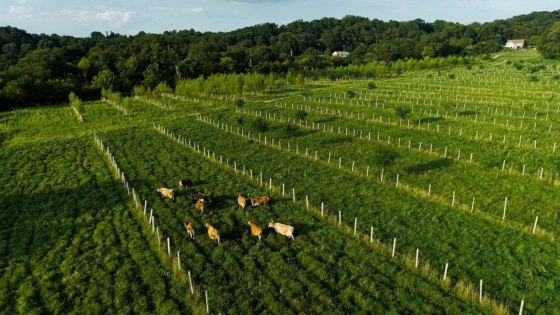
An aerial view of the silvopastures at Fiddle Creek Dairy in Lancaster County, PA. (Photo courtesy Savanna Institute)
The SI is a 501(c)(3) nonprofit headquartered in Spring Green, Wis. and Champaign, Ill. It was founded in 2013 in the Champaign-Urbana area by a group of researchers, students and farmers that were interested in exploring how perennial agriculture and agroforestry could benefit Midwestern farmlands.
The organization focuses on Illinois and Wisconsin but also does support work in Iowa, Minnesota, Michigan and Indiana. Its technical service program pairs farmers one-on-one with an agroforestry expert to help plan and design plantings.
[RELATED: On the Ground with the Midwest Farmers Going All-In On Agroforestry]
The SI focuses on agroforestry practices supported by the USDA. Those include alley cropping, which involves integrating trees or shrubs within annual agricultural or horticultural crops; silvopasture, in which trees are integrated into livestock production for pasture and animal health; and forest farming, which is the cultivation of crops such as mushrooms, medicinal plants or maple syrup under a forest canopy.
In addition, USDA-supported agroforestry practices include efforts to mitigate soil erosion and protect waterways. Riparian forest techniques place trees on the edges of waterways and cropland to protect waterways and prevent erosion. Windbreaks involve planting trees along edges of fields to keep soil in place, enhance crop production and protect motorists on adjacent roadways from snowdrifts and fierce winds.
Demonstrating what works
For many farmers, seeing is believing. That’s one of the reasons why Adams is enthusiastic about SI’s new statewide agroforestry demonstration farm network that will launch in Wisconsin this spring. On the demonstration sites, farmers can see examples of successful integration of trees on farms.
The effort is through an ongoing partnership with the Natural Resources Conservation Service (NRCS), a branch of the USDA. The NRCS will invest $1.4 million toward agroforestry demonstration and educational opportunities across Wisconsin, with a goal of increasing the number of landowners planting trees and other perennials on their farmland. The new agroforestry demonstration sites in Wisconsin are the third project in which SI has partnered with the NRCS. Previous projects include technical assistance programs for farmers and training NRCS staff to offer in-house agroforestry service providers.
Wisconsin’s demonstration sites program will serve three main objectives: highlighting farmers that are adopting agroforestry, allowing individuals and other farmers to engage in educational opportunities; providing peer-to-peer thesis for education and support of farmers doing agroforestry; and offering opportunity for these farms to be part of a research network.
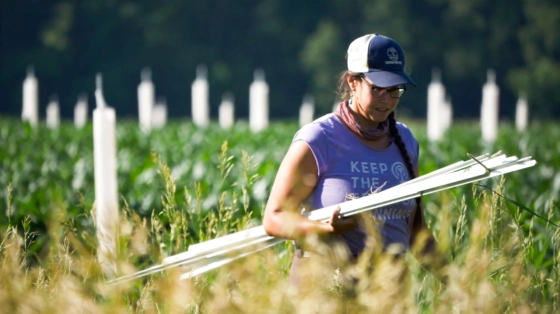
Kaitie Adams is director of demonstration and on-farm education for the Savanna Institute. (Photo courtesy Savanna Institute)
Adams says SI has already received several inquiries from farmers interested in participating in the program. Those include multi-generation family farms or beginning farmers that are adopting agroforestry or farmers transitioning from annual production to perennial production.
“Wisconsin producers have always been innovative and open to exploring ways to diversify their agriculture systems, provide their products to new markets and be good stewards of the land,” says Josh Odekirk, acting state conservationist for the Wisconsin NRCS. “Agroforestry is a sustainable land management approach that can be integrated into existing traditional crop and livestock systems. Savanna Institute is an ideal partner to help implement this work.”
Odekirk adds that Wisconsin NRCS has new funding through the 2022 Inflation Reduction Act (IRA) to implement climate-smart conservation practices that benefit conservation and a producer’s bottom line. “Agroforestry conservation practices are eligible for standard Farm Bill funding as well as IRA funding in both the Environmental Quality Incentives Program and Conservation Stewardship Program.”
For the fiscal year 2024, Odekirk says Wisconsin received more than $41 million in IRA funding over and above their standard Farm Bill funding.
Removing barriers to an original form of agriculture
Adams calls agroforestry one of the original forms of agriculture that’s been utilized around the world. The types of trees and shrubs integrated into agroforestry depend on the type of farm, its crops and its needs.
Savanna Institute and the NRCS focuses on trees and perennial crops that are native or native-adjacent to the area. Windbreaks might integrate native conifers and evergreens, along with hardwoods such as hazelnut, chestnuts, berry fruits and shrub fruit.
Due to Wisconsin’s proud history of dairy production, silvopasture is becoming a common agroforestry practice used in the state, says Adams, and Wisconsin’s rich abundance of woodlands also lends to forest farming.
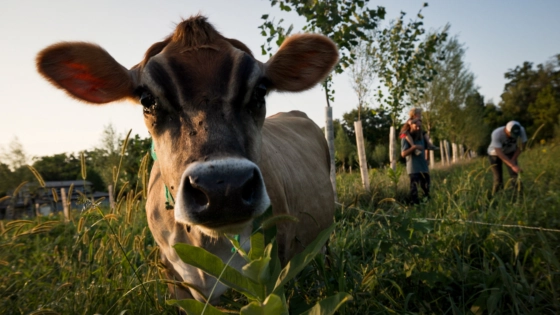
Silvopasture integrates trees into livestock production for pasture and animal health. (Photo courtesy Savanna Institute)
The new agroforestry demonstration farm network in Wisconsin will help to remove barriers to implementing agroforestry practices, says Adams. Shifting from annual crops to perennial crop production—particularly with trees, which often outlive the person that plants them—requires a shift in mindset and skillset.
“The cost of planting 500 trees is very different [from] the cost of 500 annual plants. But the great thing about perennials is that you make that big investment once, and then it pays off over time, rather than having to do the same costs year after year,” says Adams.
Partnering with NRCS gives farmers access to programs that can help cost-share and provide technical assistance to get trees in the ground. Adams notes they also pay farmers for offering education, research and outreach.
Blooming ecological success
Maggie Taylor of Delight Flower Farm, a commercial cut-flower farm in Champaign, Ill., has always been ecologically minded. As her business grew from a small plot in a backyard garden to the five-acre farm she purchased in 2019, Taylor tapped into USDA cost-share contracts that reward conservation practices.
Owning her own property opened possibilities of investing in more perennial plants and permanent infrastructure to grow the business. Through Adams, Taylor had worked with SI to create a plan for integrating trees and shrubs on her property. “I had primarily done cut flowers as annual crops or grew in a greenhouse, so I didn’t have a lot of experience or knowledge of perennials. Savanna Institute was a great resource for me.”
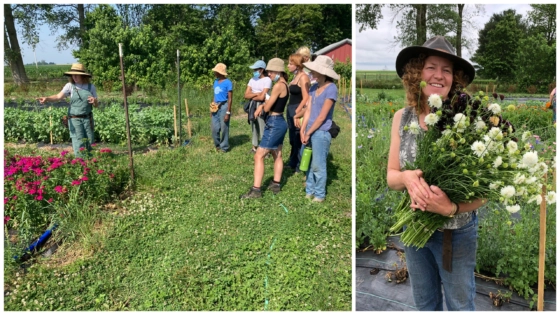
Maggie Taylor shows perennial agriculture methods to curious gatherers. (Photos courtesy of Maggie Taylor)
Taylor uses alley cropping, through which she mixes perennial crops such as holly with her annuals. She harvests the holly during winter to sell as holiday greenery. She also plants coralberry, red osier dogwood and elderberry. These plantings help sequester carbon, protect the soil’s ecosystem and create habitat for birds, insects and small wildlife.
Taylor also installed windbreaks, planting two rows of white pine, interplanted with red cedar, blue spruce and Colorado spruce. An interior row of the property consists of witch hazel and coralberry. These lower shrubs provide wildlife habitat, along with sellable products such as holly and berries.
“Twenty years ago, there was a buzz about people replacing standard American lawns with raised beds to reduce environmental impacts of lawn chemicals,” says Taylor. “Agroforestry is a level above that conversation with the same intentionality, planting trees for the benefit of the property owner, the environment and the ecosystem as a whole.”
Learn more about agroforestry
Want to expand your knowledge of agroforestry? Savanna Institute’s online course series includes topics such as Agroforestry Foundations, Social Justice and Agroforestry, Perennial Crops and Practices in Agroforestry, Managing Agroforestry Systems in a Changing Climate,and Land Access and Finances in Agroforestry. Some classes are free, while others are $40.
Savanna Institute’s website also includes downloadable publications, including its book Perennial Pathways: Planting Tree Crops. Its apprenticeship program pairs people in the Midwest interested in agroforestry to work with mentors to gain hands-on experience. The organization also hosts a yearly perennial farm gathering, workshops, events and the podcast Perennial AF.
Have a question about planting trees? Ask your question in the comments—we’ll have an expert agroforester from the Savanna Institute answer reader questions in a future story.
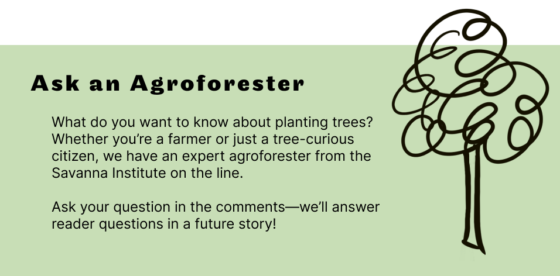
Is there a comparable program to help new farmers enter into agroforestry, including forest farming, in mountain area of Maryland?
Yea this is all neat stuff however you are missing the most vital component. Remember that eventually every bit of CO2 absorbed by a tree gets back into the environment. When the tree dies it decomposes and releases all the CO2
Using the wood as fuel to offset fossil fuels: Yes the CO2 gets back into the atmosphere BUT we have kept CO2 from fossil fuels out of the atmosphere,